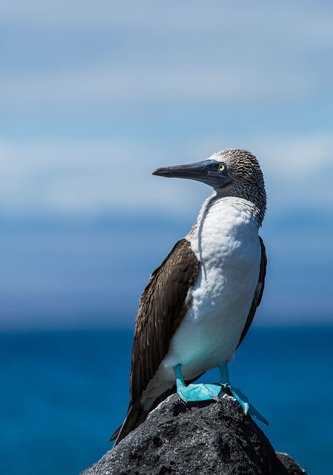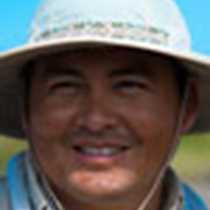Our second day in the Galapagos archipelago was very memorable, beginning with our first outing at North Seymour, which is a small uplifted seabed near Baltra Island. It is just about two square kilometers of land, with a maximum elevation of ninety-two feet.
Our first outing took place along the rocky shoreline, on a loop trail that took us through the unique landscape of pillow lava sections and bushy vegetation, made up of cacti and small palo santo trees. The trail is about 1.2 miles/2 km in length, and we were rewarded with excellent wildlife sightings at the end! Along the rocky stretch, we found a variety of different sea birds nesting, such as swallow-tailed gulls, blue-footed boobies, and both magnificent and great frigate birds. Many of these species were rearing their chicks, while others displayed their courting behaviors, and others were still incubating their eggs. Land iguanas, which were translocated from Baltra Island to North Seymour by Captain G. Allan Hancock in the 1930s, were also sighted. There was so much to see, but eventually it was time to head back to our ship, to start sailing west towards Rabida Island.
In the afternoon, the National Geographic Endeavour took us to the Rabida, also known as Jervis Island in honor of the 18th century British admiral John Jervis. This unusual island is sometimes called the Terracotta Island, and it is particularly known for its red sand beach and a saltwater lagoon that is inhabited by wading birds and sea lions. The landscape is studded with small volcanic features along sharp slopes and cliffs. The first outing in this island was snorkeling, and the rich waters of this place made the underwater experience unforgettable. Our guests that were overjoyed with the biodiversity that characterizes Rabida Island, including endemic Galapagos marine iguanas, spotted white tipped reef sharks, sea turtles and different kind of fish.
Later in the afternoon, our explorers went ashore to have a short walk along the red sand beach. Migratory birds and white-cheeked pintail ducks were sighted in a brackish lagoon behind the beach. Our walk ended with a beautiful display of the blue-footed boobies plunge diving nearby the shore. It was another exciting and unforgettable day in the Galapagos.









